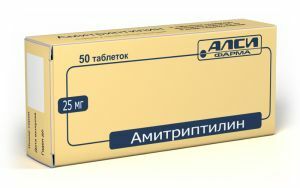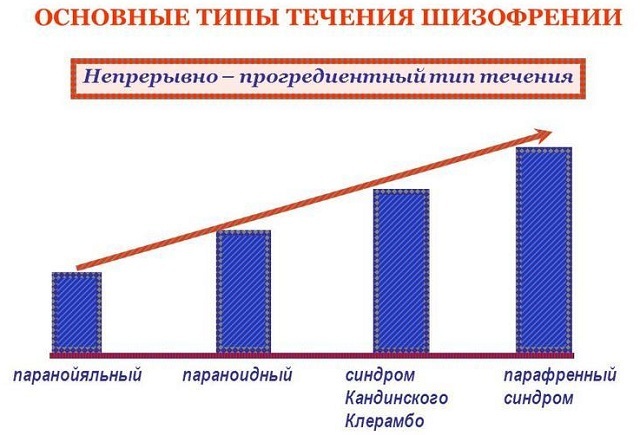 Cotard syndrome( depressive nihilistic nonsense) accompanies certain psychiatric illnesses. In this case, the patient expresses grotesque hypochondriacal thoughts, and also is in a state of severe depression, close to the suicidal state.
Cotard syndrome( depressive nihilistic nonsense) accompanies certain psychiatric illnesses. In this case, the patient expresses grotesque hypochondriacal thoughts, and also is in a state of severe depression, close to the suicidal state.
The disease is quite rare. This syndrome includes several manifestations of mental disorders:
- severe depressive condition;
- violation of an adequate perception of the surrounding world;
- actually nihilistic nonsense Kotara - hypochondriacal thoughts of extreme severity.

Contents
- Historical data
- Reasons for deviation development
- Manifestations and clinic - how to suspect something is wrong?
- Treatment measures
- Antipsychotic drugs
- Taking antidepressants
- Taking anxiolytics
Historical data
For the first time the syndrome of a living dead was described in 1880 by the French specialist in psychiatry and neurology Jules Kotar. He called this syndrome a delusion of denial.
His first patient was a woman, confident that she had long since died. She persuaded others that her veins were empty, her heart was gone for a long time. Simultaneously, the patient experienced severe depression. Jules Cotard considered that in this case there is a complete denial of the existence and life of all mankind.
Currently, the disease is named after his name. It is believed that with this syndrome there is a violation of temporary perception - patients can not adequately assess the past and future. They believe that they are dead people, their bodies are missing. Some consider themselves to be aliens from other worlds.
Reasons for the development of the deviation
Causes of the disease are a variety of mental disorders:
- depressive psychosis;

- schizoid disorders;
- depressive form of schizophrenia;
- progressive paralysis;
- severe cerebral arteriosclerosis;
- senile dementia;
- senile psychosis.
Cotar syndrome can develop in people of any age. More often observed in the elderly and the elderly. Most cases are observed in women.
Manifestations and the clinic - how to suspect something is amiss?
For severity of mental changes, Cotard's syndrome is divided into two degrees of severity:
- At the first degree of , patients experience marked disgust and self-hatred. They are prone to masochism, they seek to inflict various injuries. They often try to commit suicide. Patients justify their behavior by the fact that they are capable of causing harm to the surrounding people or the whole world.
- With the second degree of , the more severe, the mental changes are more pronounced. Patients assure themselves and others that they have long been dead, all organs and blood have disappeared from their body. They can also express the thought that the organs are in place, but are subject to the process of decay. Patients are convinced that their body exudes a fetid smell. They also believe that everyone is dead.
Cotard syndrome has many symptoms. Since patients are sincerely convinced that they are right, this causes them to experience serious mental suffering. The main manifestations of pathology:
- megalomania;
- expressed nihilistic beliefs;
- excessive anxiety;
- severe depression, turning into suicidal tendencies;
- hallucinatory attacks;
- hypochondriacal thoughts.

Mania of greatness is manifested in the fact that patients consider themselves special - aliens from other worlds, designed to destroy all life. They believe that they bring to all mankind various sufferings that are guilty of all catastrophes and natural disasters.
Simultaneously, hypertrophied nihilism is observed. A patient with Cotard's syndrome believes that neither his life nor the life of the whole of mankind makes any sense. This symptom also includes thoughts about the absence of vital organs in the body. In this regard, patients often refuse to eat and may even die from exhaustion.
Increasingly, anxiety and depression increase. The result is suicidal attempts. At the same time, the patient is convinced of his immortality, believing that it was given to him for an eternal trial. It is this belief that causes patients to do themselves serious damage.
Cotard syndrome is accompanied by the formation of all kinds of hallucinations:
- olfactory - the patient believes that exudes stench;
- auditory - voices tell about upcoming tests;
- visual - patients see all kinds of monsters.
Characteristic and motor manifestations: 
- neurotic movements - patients wring their hands, twist their hair, teasing their clothes;
- in severe cases there is pronounced motor excitation - patients can not sit still, constantly walk from side to side;
- speech excitation - an incoherent stream of words can be observed;
- after an attack of motor excitement is observed stupor .
The diagnosis is based on a typical clinical picture.
Treatment measures
Cotard syndrome is almost not amenable to therapy, as there is no critical assessment of patients' condition. The most frequently cured patients with the disease, which was caused not by severe depression or somatic pathology.
Initially, the underlying disease should be eliminated. Treatment includes the use of the following drug groups:
- antipsychotics;
- antidepressants;
- anxiolytics.
Antipsychotic drugs
These include agents used to treat psychoses of various origins:
- Rispolept .The active substance in its composition is risperidone. The drug is able to reduce the manifestations of schizophrenia, including psychotic conditions. Be wary appoint patients with severe cardiovascular pathology, cerebral circulatory disorders, Parkinson's disease, brain tumors, Lewy body disease. Of side effects, headaches and dizziness, tachycardia, insomnia.
- Aripriazole .The active substance in the composition is aripiprazole. The drug suppresses the symptoms of schizophrenia and bipolar disorders. It is used with caution for the treatment of patients with severe cardiovascular pathology, convulsive episodes in the anamnesis, with diabetes mellitus. Of side effects noted insomnia, dizziness, tachycardia.
Taking antidepressants
These drugs help to eliminate depressive disorders of varying severity:
- Amitriptyline .Refers to tricyclic antidepressants. The mechanism of action is to suppress the re-uptake of
 serotonin - thus, serotonin has a more pronounced and long-lasting effect. Contraindicated in any cardiac pathology, renal and hepatic insufficiency, pathology of the gastrointestinal tract. Of side effects noted deterioration of vision, dry mucous membranes, constipation.
serotonin - thus, serotonin has a more pronounced and long-lasting effect. Contraindicated in any cardiac pathology, renal and hepatic insufficiency, pathology of the gastrointestinal tract. Of side effects noted deterioration of vision, dry mucous membranes, constipation. - Févarine .The active substance in the composition is fluvoxamine. The mechanism of action is suppression of reuptake of serotonin. It is several times greater than that of Amitriptyline. Contraindicated in the treatment of MAO inhibitors. With caution apply for renal-hepatic insufficiency, pathology of blood coagulation, epilepsy. Of side effects, dyspeptic phenomena, headaches, tachycardia are noted.
Admission of anxiolytics
The agents of this group contribute to the suppression of anxiety:
- Grandaxin or Mebikar .It is a derivative of benzodiazepine. Eliminates anxiety, does not have hypnotic and
 muscle relaxant effect. Contraindicated in respiratory failure and severe psychomotor agitation. Out of side effects, headaches, irritability are noted.
muscle relaxant effect. Contraindicated in respiratory failure and severe psychomotor agitation. Out of side effects, headaches, irritability are noted. - Afobazole .Nebenzodiazepine anxiolytic. Does not disturb memory and concentration of attention, does not have a hypnotic effect. Contraindicated in pregnant and lactating women. Of side effects, it is possible to develop an allergic reaction.
Treatment of Cotard syndrome is carried out under in-patient conditions under the supervision of medical personnel. Electro-convulsive therapy is used for severe forms of the disease.
After arresting the underlying disease, psychotherapeutic sessions are prescribed to eliminate the immediate nihilistic delirium of Kothar.
The disease is not always successful in therapy, but it is possible to significantly reduce its manifestations.



